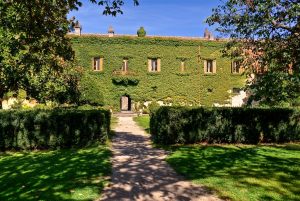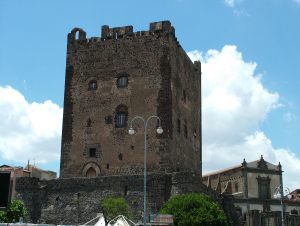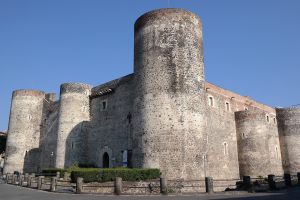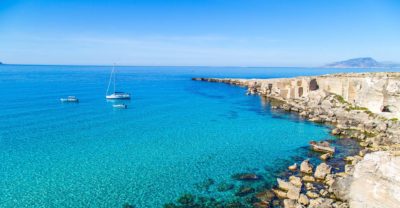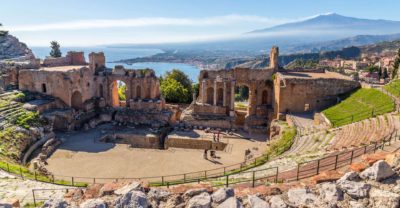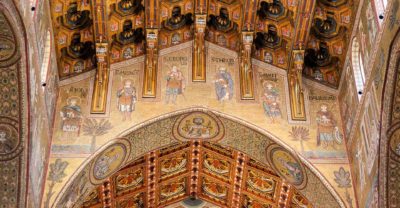Towers and Castles
Catania
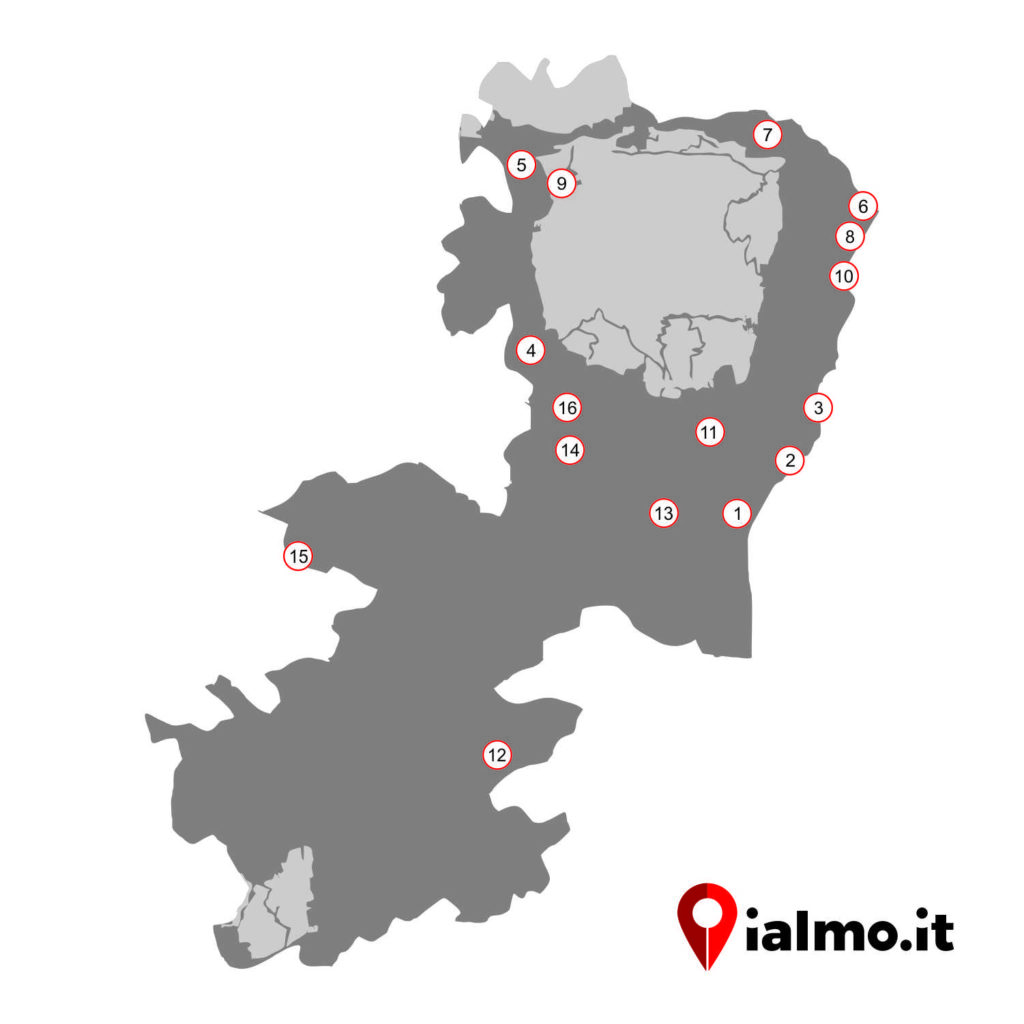
Castello Ursino, Catania: 13th century castle built by the will of Frederick II of Swabia. Today it houses the Museo Civico, with the collections of Biscari and the Benedettini. The structure was used as a Sicilian Parliament in 1295 and faced all the most bloody stages of the War of Vespers. Later it was used as a royal residence. The Castle has a square base with only two surviving towers of the original four. It is surrounded by a drawbridge and a moat once filled with water as an element of defense. From the sixteenth to the nineteenth century it was used as a prison, as evidenced by the still visible drawings made by the prisoners on the walls, on the doors and in the external courtyard.
Castle of Aci, Aci Castello: the date of origin of the structure is still unknown but probably it was built at the time of the Norman domination using the lava stone of Etna. Over the centuries it belonged to the possessions of Ruggero di Lauria, Giovanni di Aragona and Alagona. In 1126 the stronghold welcomed, inside the small Byzantine chapel, the relics of Sant’Agata arrived from Constantinople (as evidenced by the remains of a fresco still visible inside). The castle stands on a promontory from which you can enjoy a spectacular view of the sea and is accessed via a long stone staircase. Originally it was equipped with a drawbridge, but today there is no trace of it except for a few remains that highlight its location. The Castle has a central tower, the so-called Donjon, a small courtyard where a botanical garden is open all year round, a large terrace with a breathtaking view and currently houses the Museo Civico.
Castello Pennisi di Floristella, Acireale: Also known as Scammacca Castle because it was built on a vineyard that originally belonged to the Scammacca barons, the Castle, in Gothic style, was built in 1882 by the architect Giuseppe Matricolo. Inside you can admire the large rooms with frescoes by Giuseppe Sciuti who created them for Baron Salvatore Pennisi as a thanks for his hospitality in 1907. The halls are furnished with nineteenth-century style furniture and in the complex there is also a small church dedicated in San Giovanni Battista. Also in Acireale near the hamlet of Santa Tecla it is possible to see the Torre del Greco, the ancient guard garret, dating back to 1500, which had the task of defending the city from pirates coming from the sea.
Norman Castle of Adrano, Adrano: located in the center of the main square, it is the most prestigious civil monument of Adrano, symbol of the city. The Castle was built in the eleventh century at the behest of Count Roger probably as a military tower on a pre-existing Saracen building. Rebuilt in the fourteenth century, it is today presented with a square plan surrounded by a low bastion with small towers placed in the corners to reinforce the entire structure. After the Norman rule, over the centuries the Castle became the property of famous and illustrious Sicilian dynasties, among which the Peralta, the Sclafani and the Counts Alvarez of Toledo. From the beginning of the XIV century the Castle was inhabited by the representatives of the Counts Moncada, owners of Adernò, but already at the beginning of the seventeenth century the upper floors were uninhabited and only the ground floor was used as a prison. The earthquake of 1693 demolished all the ceilings and crenellations leaving only the perimeter walls intact. Repair work took place in the eighteenth century but in the following century only the first floor of the tower that served as a prison remained accessible. In the fifties the castle was freed from prison and gradually restored. Since 1958 it houses the Etneo Archaeological Museum, the art gallery and a library. Noteworthy to the Adrano, the Castello della Solicchiata located a few kilometers from the town. The castle, built in lava stone and surrounded by a moat, is accessible via a drawbridge. It was built around 1875 at the behest of Baron Spitaleri and became an important industry for the production of the homonymous wine.
Nelson Castle, Bronte-Maniace: Also known as Ducea di Maniace, the building is located about 10 kilometers from the town, exactly on the border between the towns of Bronte and Maniace. Founded in the twelfth century by Queen Margaret of Navarre, wife of William I of Sicily, in 1799 the castle was donated together with the fief by King Ferdinand I of the Two Sicilies to the English admiral Horatio Nelson as a sign of gratitude for having repressed the so-called Neapolitan Republic saving him life and the kingdom. The entrance of the building is solemn: through a large covered portico you enter a large courtyard that serves as the center of the whole complex and where there is a large Celtic cross dedicated to Admiral Nelson. Immediately to the left, through a large door you enter the garden of the castle where there are English lawns, a gushing fountain with fish and in the center a putto hugged to a dolphin. To the right of the courtyard is the Church dedicated to the Madonna di Maniace, a noble example of late Norman architecture. The Church, where is preserved a precious Byzantine icon of the Madonna of the eleventh century, suffered serious damage during the earthquake of 1693 that deprived it of the entire apse starting from the triumphal arch of which, in the flat bottom wall, you can see still traces. The ancient castle remains little because the rooms were readapted by the heirs of Nelson for housing purposes or as warehouses serving agriculture but can be visited and exhibit some vintage relics belonging to the admiral.
Castle of San Marco, Calatabiano: located on the beach of relevance of the city and was built in the seventeenth century on commission of the princes of Palagonia. Originally it included several buildings grouped together but of which today there is no trace left except for the church dedicated to the cult of St. Anthony of Padua. In the nineteenth century it became the property of the Pennisi barons of Floristella, originally from Acireale, who enlarged it with houses for farmers and cellars.
Torre del Cannizzu, Castiglione di Sicilia: built between the twelfth and fourteenth century, it is located outside the city walls, in one of the most picturesque places in the country for the splendid panorama overlooking the Alcantara valley. The tower, six meters high and three meters wide, was probably part of a more complex fortification, called “Cittadella”, and was the first stronghold to be conquered by Frederick III, king of Sicily, when, in 1301, regained the fief, taking it away from Ruggiero di Lauria. She was struck by a lightning bolt that split it in half and is still visible the cement scar introduced to prevent the collapse of the structure. Still noteworthy in Castiglione di Sicilia there are Castel Leone and Castelluccio. The first one is located inside the inhabited center and is accessed through a large flight of steps leading to the entrance in an ogival arch. Made of sandstone, Castel Leone is spread over two levels with inside the remains of the rock Church of Santa Barbara. Still today are visible cisterns for water collection, the remains of a chimney that was a smoke detector and the Byzantine era prisons. The Castelluccio, located near Castel Leone, is a sort of outpost of the defense wall of Castiglione di Sicilia. The structure, dating from the twelfth century, is made of square-shaped sandstone blocks and can be accessed from the main square of the village. To date, two pieces of straight wall are visible, which turn into a meeting point in the form of an acute arc.
Castello degli Schiavi, Fiumefreddo di Sicilia: typical example of eighteenth-century Sicilian baroque, stands along the road connecting the coast of Marina di Cottone. It was a film set of many features, including the saga of The Godfather in the seventies. Its name is linked to the legend according to which the son of the Gravina-Cruyllas, then barons of the fief, was saved by a local doctor, Gaetano Palmieri, who in return received from the princes this possession he used as a place to stay. The doctor’s wife appreciated the choice because it was easier for her to meet her lover Nello Corvaja from Taormina, who saved the two spouses during a pirate attack on the coast. From this episode derives the construction, in the loggia, of two statues depicting two Turkish figures with their gaze turned towards the sea, awaiting the release of their companions. Beautiful interiors with frescoes, furnishings, coats of arms and precious antiques, in addition to the entrance door in lava stone that overlooks a garden full of vegetation. The castle is privately owned, but the visit is possible by prior appointment with the owners.
Maletto Castle or Torre del Fano, Maletto: The origin of Maletto dates back to 1263, when, under the Swabian domination, Manfredi Maletto, Count of Mineo, built a watchtower and communication tower called Torre del Fano on a rocky spur. Since then, the place was called Maletto and over time the fortified tower became a castle and around it the first houses were built. Today only a few ruins remain of the ancient castle on the top of a high cliff of sandstone rock and among the ruins there are only three rooms, of which the northern one seems to recall the ancient forms of a quadrangular tower. The masonry is characterized by lava stone not squared and tied together by good quality mortar, all jammed with fragments of bricks. In the north and east direction there are remains of the original walls. The building is accessed from the south-eastern side of the fortress, through an iron gate located at the Church of St. Anthony of Padua. Once you pass the entrance, you continue climbing on the characteristic steps carved into the rock.
Ancient Tower, Mascali: now reduced to simple ruins, it was a building with a robust and regular structure, with defensive military functions. The building, in Gothic style, was built with lava stone and opened on a square base. The structure was severely damaged by the earthquake of 1693, during which the tower was deprived of its upper part. In the walls of the fortress are visible some loopholes and higher up a large window with a majestic overhanging lintel, in lava stone.
Torre di Grifo, Mascalucia: it is a work of military architecture built with the intention of controlling the surrounding countryside. The Tower appears in the chronicles of the sixteenth century, where it describes a large volcanic eruption that from Fontanelle unraveled along the so-called Schiena dell’asino, up to Sant’Antonio and, in fact, to Torre del Grifo. Today there are only a few ruins of the Tower in a context of decay, but it is still possible to understand its observation and avant-garde function, for its strategic position.
Torre Normanna, Militello in the Val di Catania: defensive construction of the Norman era, used as a residence and was originally linked to the structure of the Church Santa Maria La Vetere. The Tower has a quadrangular construction, distributed on several orders up to a height of about 20 meters. The lower part is set against the rocky ridge of the hill. The first floor, instead, supported by a barrel vault in stone blocks, has a large window to the north, with a large shelf. On the second floor, mostly destroyed, there is still a part of the wall facing east. Also in Militello, in the Val di Catania, we point out the Castello Barresi Branciforte which, built in 1200, was partly leaning against the circuit of the medieval walls and separated by a moat on the west side. It was enlarged and richly decorated over the centuries. We also point out the Fountain of the Ninfa Zizza in the southern courtyard of the Castle, a wonderful expression of sculptural art built in 1607 to celebrate the construction of the aqueduct.
Motta Tower, Motta Sant’Anastasia: The Tower of Motta (or Dongione) was built between 1070 and 1074 on the remains of an Arab tower at the behest of Roger d’Altavilla. The massive rectangular tower, about 21 m high, is a good example of typical defensive structure of the late Middle Ages. The terrace roof preserves almost intact the battlements (22 rounded head merlons). The structure is divided into three elevations: only the first of these still has the original windows, pointed arch on the outside and round on the inside. The other square windows of the other levels and the entrance door date back to the 15th century.
Norman Castle, Paternò: is the symbolic monument of Paternò. Built by Roger I of Altavilla in 1072, according to the statements of the contemporary Benedictine monk Goffredo Malaterra would have risen on some remains of an Arab defensive construction. Over time the building has also assumed an administrative and residential function. Among the many historical figures who have resided there, the most famous was certainly Frederick II of Swabia, who stayed there in 1221 and 1223. Inside the rooms are still well preserved; in the chapel there are paintings dating back to 1200 representing the Annunciation, a Nativity and a Solemn Christ.
Torre del Feudo, Raddusa: erected during the eighteenth century on a rock outcropping from the ground, the Tower has an irregular octagonal plan. Still intact in the wall structures, the Tower rises about 10 kilometers from the town and exactly at the junction of the Giumenta.
Torre di Calafato, Santa Maria di Licodia: The Tower of Calafato stands out for its beauty and for the mastery of its construction technique, it has a structure in lava stone, and rises like a stepped pyramid with a rectangular plan. At the top of the tower, a walkable floor surrounded by stone seats. The tower is clearly visible from the road that runs alongside it but can only be visited with the permission of the current owners. Of uncertain date, for some it would probably be a place of worship, for others instead of a tomb of Greek origin. Another hypothesis was put forward, according to which it would be the work of local entrepreneurs, rearranged towards the end of the nineteenth century as a lookout for the countryside or as a “pitrera”.
